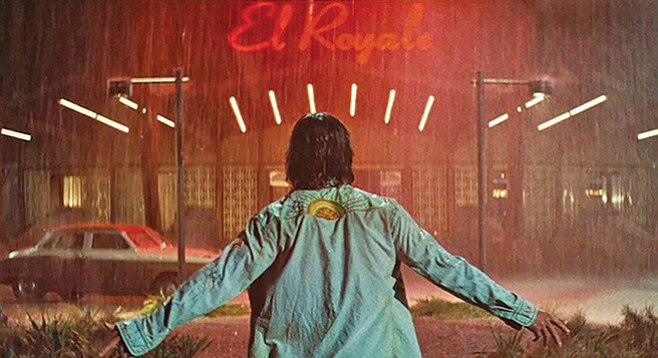 Facebook
Facebook
 X
X
 Instagram
Instagram
 TikTok
TikTok
 Youtube
Youtube

In 2012, writer-director Drew Goddard took a bunch of teens to a Cabin in the Woods for a rollicking nightmare subversion of the horror genre. Here, he takes a bunch of strangers — Jeff Bridges’ confused cleric, Jon Hamm’s slick salesman, Dakota Johnson’s haughty hippie, and Cynthia Erivo’s suffering singer, for starters — to a remote motel for a much more sincere but equally considered take on a familiar theme. Of course, the theme being what it is — secrets laid bare and bodies laid out over the course of one long and rainy night — there’s still plenty of “nothing is as it seems” at the outset. (Hamm’s strained southern accent is your first clue.) The opening scene encapsulates his approach: the camera holds on a haggard man arriving in his dim motel room, moving the furniture, rolling up the carpet, pulling up the floorboards, hiding a satchel, restoring everything, and then sitting down to wait for what’s next, all set to a cheerful tune about escaping to an island paradise. The rest of the film is prettier to look at — Goddard is clearly a man who views his setting as a character, and he has a winner in his bifurcated getaway, half in California, half in Nevada — but built along the same lines: careful framing, mysterious characters, slow builds, violent surprises, and a dynamite parade of very nearly on-the-nose songs from the mid to late 1960s.


In 2012, writer-director Drew Goddard took a bunch of teens to a Cabin in the Woods for a rollicking nightmare subversion of the horror genre. Here, he takes a bunch of strangers — Jeff Bridges’ confused cleric, Jon Hamm’s slick salesman, Dakota Johnson’s haughty hippie, and Cynthia Erivo’s suffering singer, for starters — to a remote motel for a much more sincere but equally considered take on a familiar theme. Of course, the theme being what it is — secrets laid bare and bodies laid out over the course of one long and rainy night — there’s still plenty of “nothing is as it seems” at the outset. (Hamm’s strained southern accent is your first clue.) The opening scene encapsulates his approach: the camera holds on a haggard man arriving in his dim motel room, moving the furniture, rolling up the carpet, pulling up the floorboards, hiding a satchel, restoring everything, and then sitting down to wait for what’s next, all set to a cheerful tune about escaping to an island paradise. The rest of the film is prettier to look at — Goddard is clearly a man who views his setting as a character, and he has a winner in his bifurcated getaway, half in California, half in Nevada — but built along the same lines: careful framing, mysterious characters, slow builds, violent surprises, and a dynamite parade of very nearly on-the-nose songs from the mid to late 1960s.
Comments